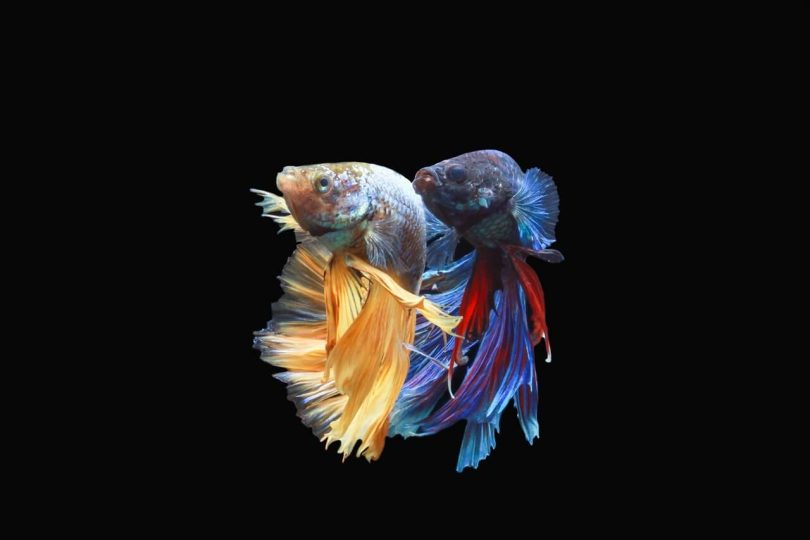Table of Contents
Betta fish, also known as Siamese fighting fish, are a popular species of freshwater fish that are known for their vibrant colors and aggressive behavior. Betta fish are often kept as pets in aquariums, and many fish owners wonder if it is possible to put two female betta fish together in the same tank.
The short answer is that it is possible to keep two female betta fish together in the same tank, but it is not always a good idea.
Female bettas can be just as aggressive as males, and they may fight with each other if they are not properly introduced or if they feel their territory is being threatened.
It is important to note that male bettas should never be kept together, as they will almost certainly fight to the death.
Before attempting to keep two female bettas together, it is important to do your research and make sure you have the right setup.
The tank should be at least 10 gallons in size and should have plenty of hiding spots and plants to provide cover and reduce stress.
It is also important to introduce the fish slowly and carefully, and to closely monitor their behavior to ensure they are getting along.
Understanding Betta Fish Behavior
The Aggressive Nature of Female Betta Fish
Betta fish are known for their aggressive behavior, and female bettas are no exception. While male bettas are more notorious for their aggression, female bettas can also be aggressive towards other fish, especially other females.
This aggression is a result of their territorial nature, which is why it is important to understand their behavior before introducing them to new tank mates.
The Importance of Space and Territory
Female bettas need space and territory to thrive. They are happiest when they have their own space to swim and explore.
When two female bettas are placed in the same tank, they may become territorial and aggressive towards each other. This is because they see each other as a threat to their own space and resources.
It is important to provide each female betta with enough space and hiding places in the tank to reduce the likelihood of aggression.
A tank size of at least 10 gallons is recommended for two female bettas. To ensure the well-being of bettas, it’s crucial to provide ample plants, rocks, and other decorations that create hiding places and obstruct their line of sight.
Signs of Aggression and Stress
Female bettas display several signs of aggression and stress when they are not happy in their environment.
Some common signs of aggression include flaring their gills and fins, chasing and nipping at other fish, and displaying dark colors. Signs of stress include lethargy, loss of appetite, and hiding.
If you notice any signs of aggression or stress in your female bettas, it is important to take action immediately.
This may involve separating the bettas into their own tanks or providing more hiding places and space in the tank.
In conclusion, while it is possible to put two female betta fish together in the same tank, it requires careful consideration and attention to their behavior and environment.
By understanding their aggressive nature, providing enough space and hiding places, and watching for signs of aggression and stress, you can create a happy and healthy environment for your female bettas.
Factors to Consider Before Putting Two Female Betta Fish Together
When considering keeping two female betta fish in the same tank, there are several factors to consider to ensure their compatibility and well-being. Here are some key factors to keep in mind:
Tank Size and Setup
The size of the tank and its setup are crucial factors to consider when keeping two female bettas together. A larger tank, with plenty of hiding spots and plants, can help minimize aggression and reduce stress. A tank size of at least 10 gallons is recommended for two female bettas.
It’s important to provide adequate filtration and maintain good water quality to prevent the spread of disease and minimize stress.
Age and Size of Betta Fish
The age and size of the betta fish can also affect their compatibility. It’s generally recommended to keep female bettas of similar size and age together.
A size difference of more than an inch can lead to aggression and bullying. It’s also important to avoid keeping a larger, more dominant female with a smaller, more submissive one.
Health and Genetics
The health and genetics of the betta fish can also play a role in their compatibility. It’s essential to ensure that both fish are healthy and free of any diseases or infections before introducing them to each other.
Betta fish with genetic defects, such as deformities or poor finnage, may be more susceptible to aggression and stress.
Compatibility with Other Fish Species
It’s crucial to consider the compatibility of betta fish with other fish species in the tank. Female bettas can be aggressive towards other fish, especially those with long fins or bright colors. It’s best to avoid keeping them with other aggressive fish or those that may nip at their fins.
Steps to Introduce Two Female Betta Fish
When it comes to introducing two female betta fish, it is important to take certain steps to ensure that they can coexist peacefully.
This section will outline the three main steps to follow when introducing two female betta fish: preparing the tank, observing the fish’s behavior, and feeding the fish.
Preparing the Tank
Before introducing two female betta fish, it is important to prepare the tank properly. To set up a new tank, follow these steps:
- Select a tank that is at least 10 gallons in size.
- Arrange plenty of hiding places, such as plants and decorations.
- Ensure the water temperature is between 76-82°F.
- Use a water conditioner to remove chlorine and other chemicals.
- Install a filter to maintain water cleanliness.
Observing the Fish’s Behavior
Once the tank is prepared, it is time to introduce the two female betta fish. Here are some steps to follow:
- Place the two fish in the tank at the same time.
- Observe their behavior closely for the first few days.
- Look for signs of aggression, such as flaring their fins or chasing each other.
- If aggression is observed, separate the fish immediately and try again later.
Feeding the Fish
Feeding the fish is an important part of introducing two female betta fish. Here are some steps to follow:
- Feed the fish small amounts of food two to three times a day.
- Make sure to feed them a balanced diet of pellets, flakes, and frozen foods.
- Avoid overfeeding, as this can lead to health problems.
In conclusion, introducing two female betta fish can be a tricky process, but by following these steps, it is possible to create a peaceful environment for both fish to thrive in.
Conclusion
In conclusion, keeping two female betta fish together can be risky and requires careful consideration. While it is possible for female bettas to coexist peacefully, they are known to be aggressive towards each other and can engage in fights that can cause serious injuries or even death.
Female bettas are territorial and can become aggressive towards other fish, especially other females. However, there are some instances where two female bettas can coexist peacefully, especially if they are introduced to each other at a young age or if they are in a large enough tank with plenty of hiding places.
It is important to note that even in cases where two female bettas appear to be getting along, there is always a risk that they may become aggressive towards each other at some point.
It is also important to ensure that the tank is properly maintained and that the water quality is good to prevent stress and aggression among the fish.
Overall, it is recommended that female bettas be kept in separate tanks to prevent any potential fights or injuries. If you do decide to keep two female bettas together, it is important to closely monitor their behavior and separate them immediately if any signs of aggression are observed.







